You just finished a tough tennis match. Your body feels the impact of every serve, sprint, and rally.
Implementing effective Post-Match Recovery strategies can drastically enhance your performance.
Muscles are tight, you’re tired, and you might wonder how long it’ll take before you feel ready to play again. The good news? With the right recovery plan, you can get back on court faster and feel better for your next match.
Understanding Post-Match Recovery is essential for every athlete.

Proper post-match recovery can cut your downtime dramatically, prevent injuries, and improve your overall performance. Smart recovery isn’t just about resting—it’s about using specific techniques that help your muscles repair, restore your energy, and prep your body for the next challenge.
Focus on Post-Match Recovery to rejuvenate your body and mind.
Utilizing proven Post-Match Recovery techniques can minimize fatigue and soreness.
Whether you play on weekends or compete often, a solid recovery routine makes the difference. The methods pros use can work for you too, and most are easy to do at home.
Key Takeaways
- Start recovery right after your match with light movement and hydration to speed up muscle repair.
- Use stretching, foam rolling, and nutrition to cover both physical and energy recovery.
- Adapt your routine based on match intensity and your fitness level to get the best results.
Understanding Post-Match Recovery
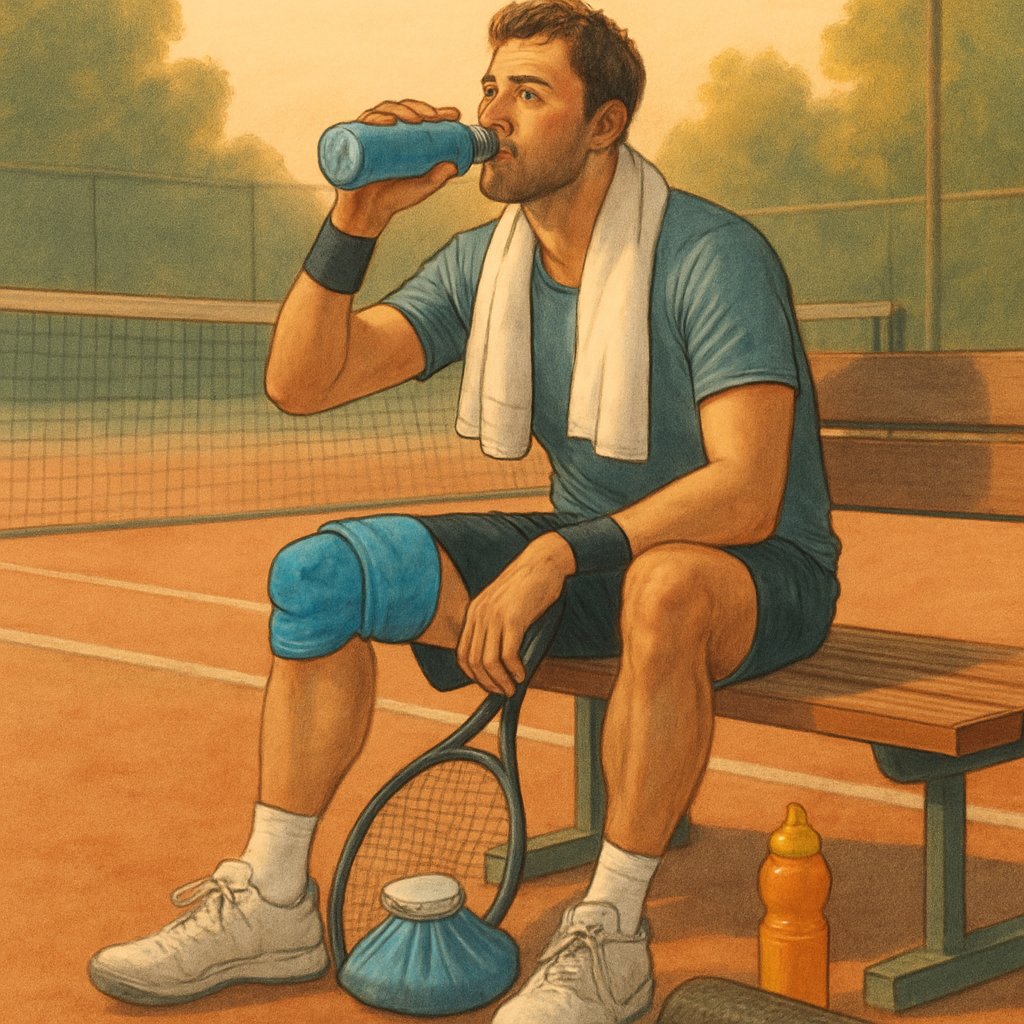
Proper recovery after tennis matches directly impacts your performance and helps prevent injuries. It focuses on fatigue and restoring your body’s energy.
Implementing Post-Match Recovery routines will help you stay on top of your game.
Effective Post-Match Recovery can be the key to maintaining high performance levels.
Why Recovery Matters for Performance
Recovery determines how soon you’ll get back to peak performance. If you skip it, your muscles stay fatigued and your energy stores remain low.
Poor recovery slows your reaction times on court. Your movement gets sluggish, and your shots lose power and accuracy.
Key performance benefits of recovery:
- Faster muscle repair
- Restored energy
- Improved focus and mental clarity
- Reduced injury risk
Recovery helps your body adapt to training stress, making you stronger and more resilient for future matches.
Prioritizing Post-Match Recovery can lead to better long-term results.
Common Causes of Post-Match Fatigue
Tennis drains your body in a bunch of ways. Knowing these helps you target your recovery.
Physical fatigue sources:
- Dehydration from sweating
- Low muscle glycogen
- Muscle damage from explosive movements
- Electrolyte imbalances
Mental fatigue hits just as hard. Intense concentration during matches burns through your brain’s energy.
Effective Post-Match Recovery is about understanding your body’s needs.
Heat stress during outdoor matches makes things worse. Your body works overtime to stay cool, burning more energy.
Long rallies and extended match times build up lactate in your muscles. That’s where that burning sensation comes from during tough points.
Developing a routine for Post-Match Recovery can enhance your resilience.
Key Principles of Effective Recovery
Effective recovery follows a few basic principles. Timing matters—a lot.
Post-Match Recovery should include hydration to replenish lost fluids.
Immediate recovery (0-30 minutes):
- Rehydrate with water and electrolytes
- Eat protein and carbs
- Start gentle movement or stretching
Short-term recovery (30 minutes-24 hours):
-
- Try ice baths or compression
Incorporating Post-Match Recovery is crucial for muscle repair.
- Get solid sleep
- Eat balanced meals
Your recovery needs shift depending on match intensity and duration. Harder matches need more aggressive strategies.
Consistency beats occasional big efforts. Make recovery a habit.
Recovery isn’t just about lying around. Light movement, good food, and targeted strategies do way more than just sitting still.
Essential Post-Match Recovery Routines
Your Post-Match Recovery plan should address both physical and mental needs.
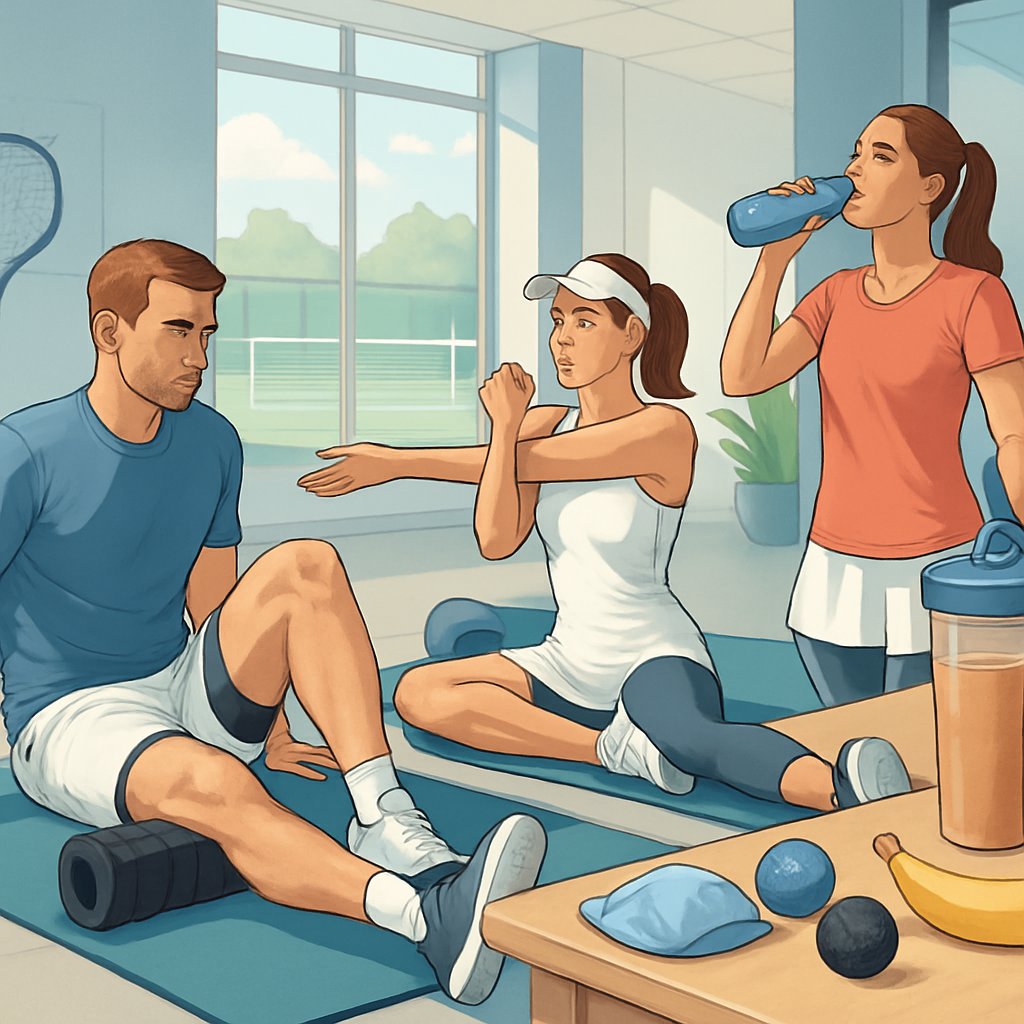
A good recovery routine after a match can cut your downtime and reduce soreness. Nutrition and hydration, paired with movement, speed up your body’s repair.
Integrating Post-Match Recovery techniques can reduce recovery time.
Active Cooldown Techniques
Active cooldown works better than just stopping. Your muscles need gentle movement to clear waste and get fresh nutrients.
Try 10-15 minutes of light cycling or walking. It keeps blood flowing without stressing tired muscles.
Active Cooldown Steps:
- Light cardio for 10-15 minutes
- Dynamic stretching
- Foam rolling for tight spots
- Gentle arm circles and leg swings
Focus on shoulders, calves, and hip flexors. Move slow and breathe deep.
Incorporate Post-Match Recovery into your training for optimal results.
Foam rolling breaks up tight spots. Roll each area for 30-60 seconds with gentle pressure.
Optimal Nutrition and Recovery Drinks
Your body needs fuel within 30 minutes after playing. That’s when your muscles soak up nutrients best.
Top Post-Match Foods:
- Protein: Greek yogurt, chocolate milk, or shakes
- Carbs: Bananas, crackers, or sports drinks
- Electrolytes: Coconut water or tablets
Shoot for 20-25 grams of protein and 30-40 grams of carbs in your first meal. Recovery drinks help if solid food feels too heavy.
Honestly, chocolate milk works just as well as pricey recovery drinks. It’s got the right mix of protein and carbs.
Hydration Strategies Post-Competition
You lose 1-3 pounds of water in a match. Replacing that is crucial.
Weigh yourself before and after matches to see how much fluid you lost. Drink 16-24 ounces for every pound lost.
Hydration Plan:
- First hour: 16-20 oz of water or sports drink
- Next 2-3 hours: Sip water regularly
- Check urine color (aim for light yellow)
Sports drinks help if you played longer than 90 minutes. They replace sodium and minerals lost in sweat.
For shorter matches, plain water is fine.
Physical Recovery Methods
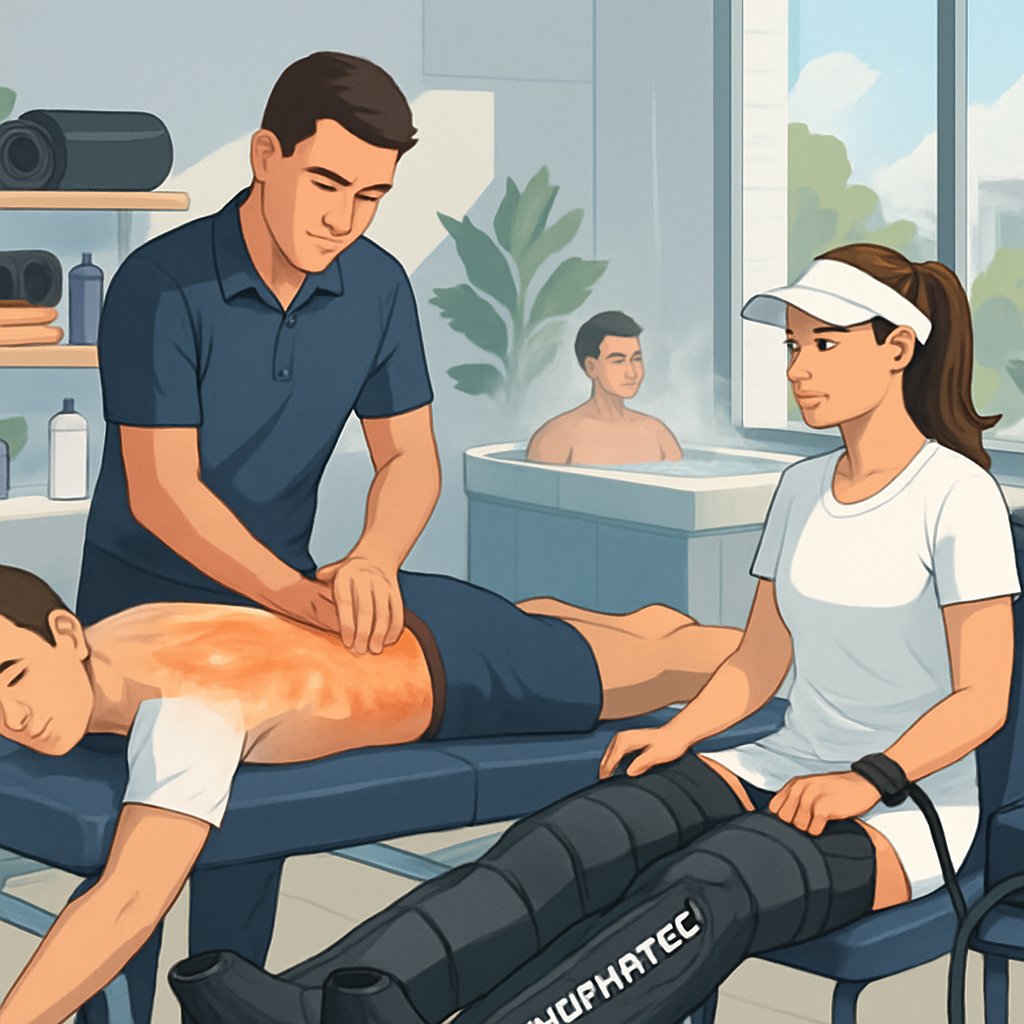
Physical recovery helps your body fix muscle damage and lower inflammation after tough matches. These methods target tension and boost blood flow.
Targeted Stretching Protocols
Understanding the principles of Post-Match Recovery will help you improve.
Post-match stretching lowers muscle tension and keeps you from getting stiff. Focus on the muscles you used most.
Hold each stretch for 15-30 seconds. Don’t bounce or push past your comfort zone.
Timely Post-Match Recovery will ensure your muscles are ready for the next competition.
Upper Body Stretches:
- Shoulder rolls and arm circles
- Chest stretches against a wall
- Neck side bends
Lower Body Stretches:
- Hip flexor stretches
- Seated hamstring stretches
- Calf stretches against a wall
Do these within 30 minutes after your match. Muscles are still warm and more flexible.
Static stretching works best after matches. Save dynamic moves for warm-ups.
Effective Massage for Muscle Relaxation
Massage boosts blood flow and helps remove waste from tired muscles. You can do it yourself or see a pro.
Regular Post-Match Recovery sessions can enhance your overall well-being.
Self-Massage Techniques:
- Use your thumbs on tight spots
- Make slow circles on sore areas
- Work from your extremities toward your heart
Focus on spots that feel sore—shoulders, lower back, calves. Spend 5-10 minutes after each match.
Professional massage goes deeper. Book a session during heavy training or after tournaments if you can.
Utilizing Foam Rollers for Soreness
Foam rolling breaks up knots and helps your muscles feel better. Roll slowly over each area for 30-60 seconds.
Areas to Roll:
- Quads: Hip to knee
- IT Band: Outside of thigh
- Calves: Ankle to knee
- Upper Back: Between shoulder blades
Use moderate pressure and breathe. If it hurts sharply, stop.
Roll across muscle fibers for best results. When you hit a tender spot, pause for 10-15 seconds.
Use foam rolling two or three times a week. Pair it with stretching for the best results.
Advanced Recovery Modalities
Advanced Post-Match Recovery methods can also be beneficial.

Cold therapy like ice baths and contrast showers can lower muscle inflammation and speed up recovery. They work by changing blood flow in your muscles.
Incorporating Ice Baths and Cold Therapy
Ice baths use water between 50-59°F (10-15°C). Soak for 10-15 minutes after your match.
The cold makes your blood vessels shrink, pushing waste out of your muscles. When you get out, fresh blood rushes in with nutrients.
Ice bath benefits:
- Reduces soreness by up to 30%
- Lowers swelling in joints
- Speeds up muscle repair
- Can help next-day performance
Start with shorter times if you’re new to ice baths. Add ice slowly—your body will get used to it.
Benefits of Contrast Showers
Contrast showers switch between hot and cold water to boost circulation. Use hot water for 3-4 minutes, then cold for 30-60 seconds.
Repeat this 3-4 times. Always finish with cold water.
Hot water opens blood vessels; cold water closes them. This pumps blood in and out, bringing fresh oxygen and nutrients.
Contrast shower steps:
- Start with warm water
- Switch to hot for 3-4 minutes
- Go cold for 30-60 seconds
- Repeat 3-4 cycles
- End with cold
Contrast showers are easier than ice baths for most folks. You can do them at home right after tennis. They work well if you don’t have access to ice baths.
Managing Rest and Recovery for Ongoing Performance
Consider how Post-Match Recovery fits into your overall training routine.
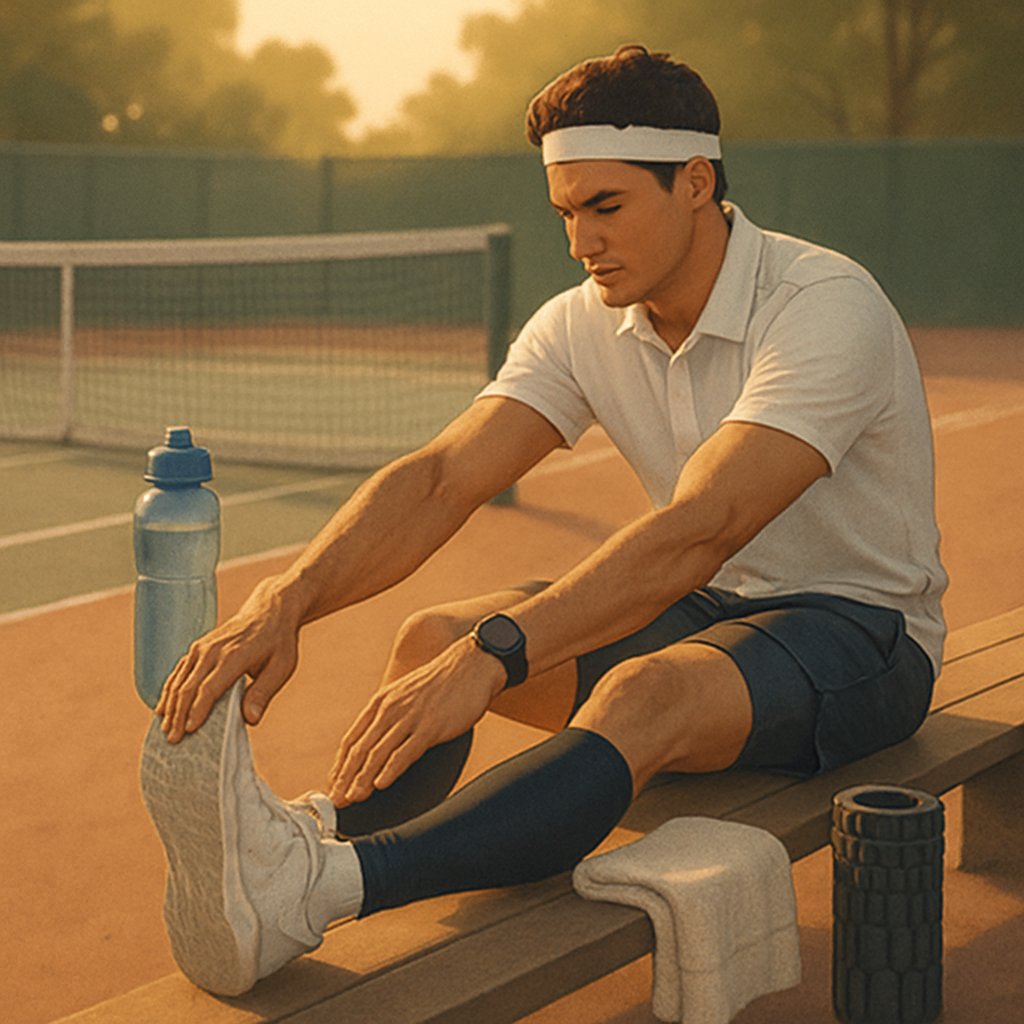
Smart recovery planning keeps injuries away and your performance steady. Building rest into your schedule and knowing when to take a break helps you play better, longer.
Structuring Rest Days and Rest Weeks
Plan rest days between hard training sessions. Muscles need 24 to 48 hours to repair after tough workouts.
Schedule one full rest day each week. On rest days, skip intense activities but try walking or gentle stretching.
Weekly Rest Structure:
- Light training days: Easy drills or technique work
- Complete rest days: No court time or hard exercise
- Active recovery: Swimming, yoga, or just walking
Take a rest week every 4-6 weeks. During that week, cut training by half but keep moving at low intensity.
Your body gets stronger during rest. Without it, your performance will stall or drop.
Signs of Overtraining and When to Rest
Watch for these signs that you need more rest:
Physical Signs:
- Muscle soreness lasting more than 2 days
- Getting sick more often
- Feeling tired even after sleeping well
- Slower reaction times
Performance Signs:
- Losing matches you usually win
- Struggling with shots you normally make
- Feeling sluggish in warmups
Take 2-3 extra rest days if you notice these. Your body needs time to bounce back.
Check your resting heart rate in the morning. If it’s 10 beats higher than usual for a few days, you might be overtraining.
Mental Recovery and Avoiding Burnout
Effective Post-Match Recovery strategies can prevent burnout and fatigue.
Mental fatigue can wreck your game just as much as physical tiredness. Take breaks from thinking about tennis and competition.
Set some boundaries. Spend time on hobbies that have nothing to do with tennis.
Mental Recovery Ideas:
- Read books that aren’t about sports
- Hang out with friends outside tennis
- Try new activities or hobbies
Aim for 7-9 hours of sleep each night. Bad sleep messes up both your recovery and focus.
Take full breaks from tennis for a week or two, twice a year. This stops burnout and keeps you motivated.
Try relaxation techniques like deep breathing or meditation. They help your mind recover from all the pressure.
Adapting Recovery to Your Experience and Training Level
Tailor your Post-Match Recovery to fit your specific needs.
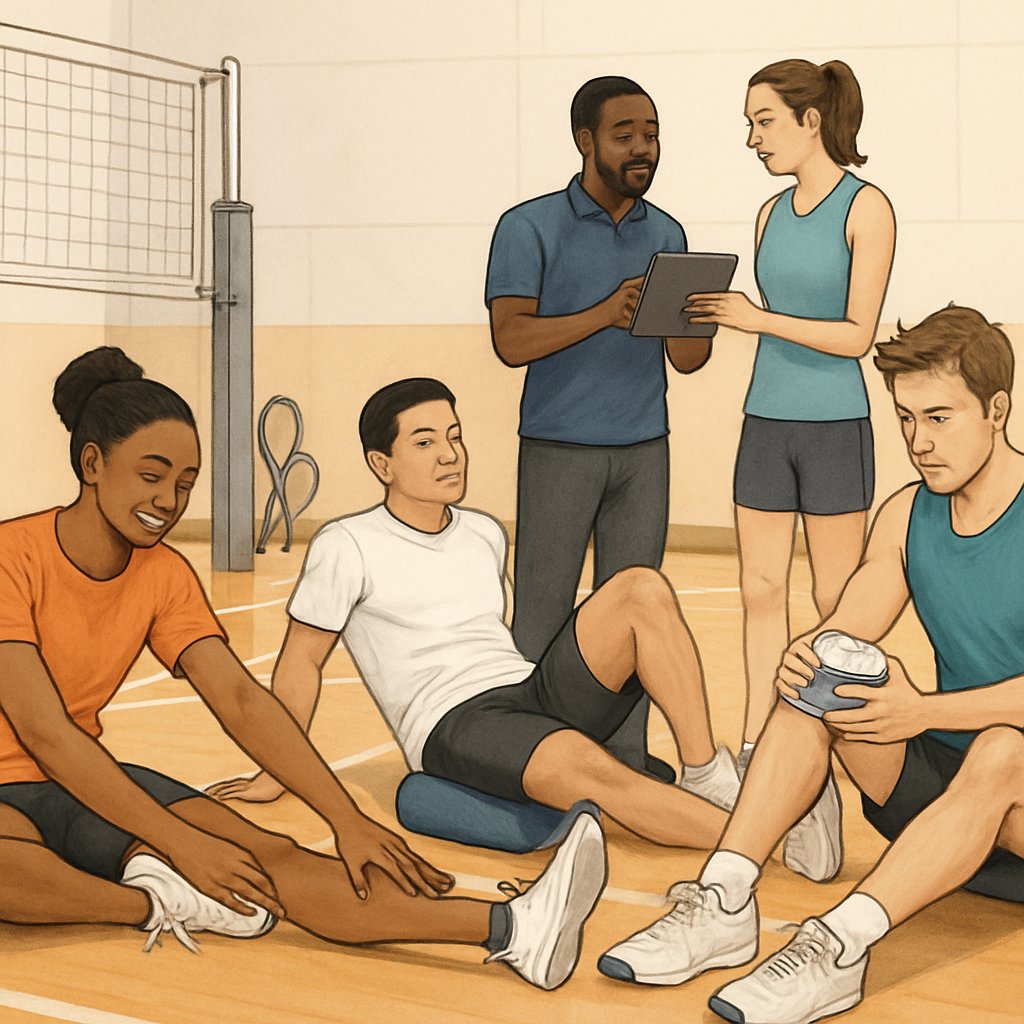
Your recovery needs shift as your athletic experience and fitness level change. Beginners and advanced athletes need different approaches.
Beginners usually need longer breaks between tough sessions. It can take your body 48-72 hours to bounce back from hard training.
Start simple. Sleep 8-9 hours, drink water all day, walk lightly on rest days, and eat some protein within two hours of training.
Experienced athletes recover faster and handle more stress. Your recovery window often drops to 24-48 hours.
You can try things like ice baths, contrast showers, and compression gear at night. Some folks even train twice a day once their bodies adapt.
The Role of Post-Activation Potentiation (PAP)
PAP means doing light activity after your main workout to boost recovery. This works best if you already have a solid fitness base.
Try easy movements that feel like your sport. For court sports, bounce a ball lightly, move gently, or do low-intensity skills for 5-10 minutes.
Do PAP activities about 10-15 minutes after your session. Your muscles stay warm, but you won’t overdo it.
Some studies say PAP can cut muscle soreness by up to 20% in trained athletes. If you’re new, stick with basic recovery first.
Customizing Your Recovery Protocol
Your recovery plan should fit your training schedule. If you train every day, you’ll need a different setup than someone training three times a week.
High-frequency trainers (5-7 days/week) should use active recovery, focus on sleep, eat on a schedule, and get regular massages.
Moderate trainers (3-4 days/week) can take full rest days, keep sleep flexible, follow basic nutrition, and use recovery treatments once in a while.
Keep an eye on your energy. If you feel wiped out for several days, give yourself more time to recover. When you feel strong, stick with your current approach.
Frequently Asked Questions
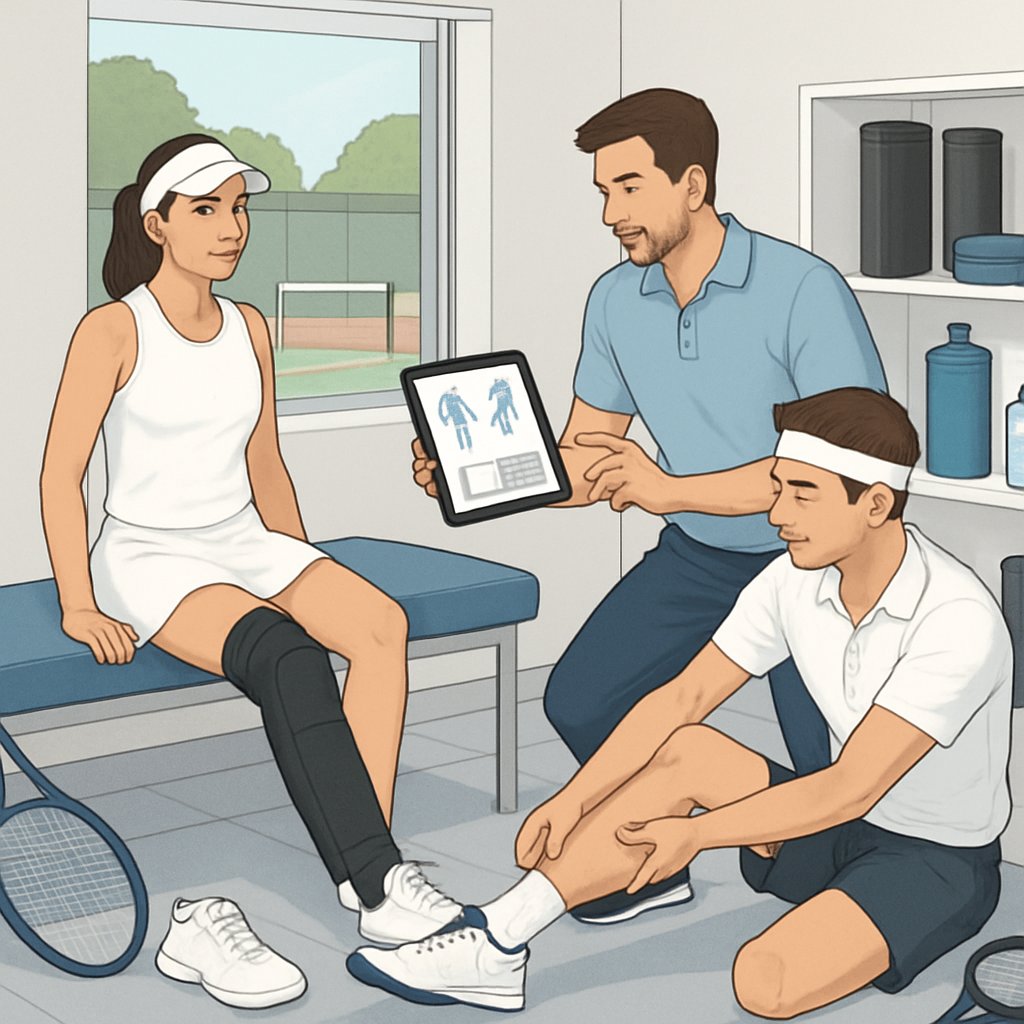
Tennis players always have questions about recovery. It’s normal to wonder how to get back to your best after a tough match.
Here’s a quick rundown of what actually helps.
What exercises help accelerate post-match tennis recovery?
Light cardio is your friend right after a match. Ten minutes on a bike or a walk keeps blood moving and helps clear out waste products.
Foam rolling works well too. Focus on legs, shoulders, and back for 5-10 minutes.
What are the best stretching techniques after a tennis match?
Dynamic stretches—like leg swings and arm circles—are great while you’re still warm. After you’ve cooled down, hold static stretches for about 30 seconds each.
Target your hip flexors, hamstrings, and shoulders. Stretching keeps you loose and helps prevent injuries.
Why do some athletes recover quicker post-exercise than others?
Age is a big factor—young athletes just bounce back faster. Training level matters too; if you’re well-conditioned, your body clears waste better.
Genetics also play a role. Some people just recover faster, plain and simple.
How can I reduce my recovery time after playing tennis?
Start your recovery within 30 minutes after you finish. Drink water with electrolytes, and eat protein plus carbs soon after.
Always start your Post-Match Recovery within 30 minutes for best results.
Aim for 7-9 hours of sleep. That’s when your body does most of its repair work.
What recovery methods do professional tennis players recommend?
Many athletes swear by their Post-Match Recovery routines for optimal performance.
Pros love ice baths or cold water therapy—10-15 minutes after a hard match helps cut down inflammation. Many also get massages regularly.
Active recovery days with light tennis drills or cross-training keep things moving. Oddly enough, taking complete rest all the time can slow you down.
What role does nutrition play in tennis recovery?
Carbohydrates refill your energy stores after long matches. Grab a banana, some rice, or a bowl of pasta within a couple of hours after you finish playing.
Protein helps repair muscle fibers that get beat up from all that intense movement. Try to get 20-30 grams from chicken, fish, or even a quick protein shake.
Hydration matters for every part of recovery. Don’t just chug water during matches—keep sipping it throughout the day.
Nutrition is a vital component of effective Post-Match Recovery.
